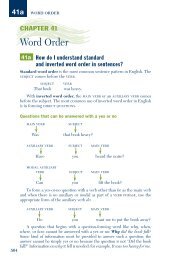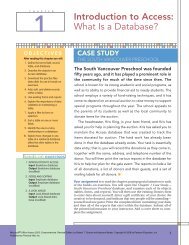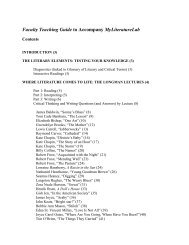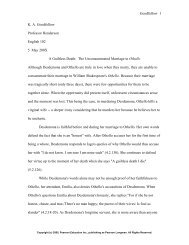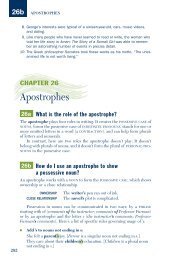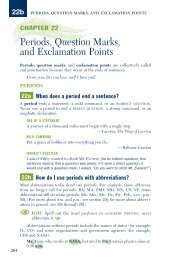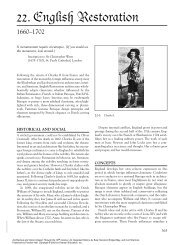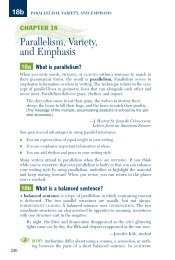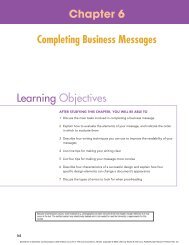JavaScript/JScript: Control Structures I - Pearson Learning Solutions
JavaScript/JScript: Control Structures I - Pearson Learning Solutions
JavaScript/JScript: Control Structures I - Pearson Learning Solutions
Create successful ePaper yourself
Turn your PDF publications into a flip-book with our unique Google optimized e-Paper software.
2008934301<br />
Chapter 14 <strong>JavaScript</strong>/<strong>JScript</strong>: <strong>Control</strong> <strong>Structures</strong> I 435<br />
small circles; these symbols are connected by arrows called flowlines, which indicate the order in<br />
which the actions of the algorithm execute.<br />
• <strong>JavaScript</strong> provides three selection structures. The if structure either performs (selects) an action<br />
if a condition is true or skips the action if the condition is false. The if/else structure performs<br />
an action if a condition is true and performs a different action if the condition is false. The switch<br />
structure performs one of many different actions, depending on the value of an expression.<br />
• <strong>JavaScript</strong> provides four repetition structures, namely while, do/while, for and for/in.<br />
• Keywords cannot be used as identifiers (such as for variable names).<br />
• Single-entry/single-exit control structures make it easy to build programs. <strong>Control</strong> structures are<br />
attached to one another by connecting the exit point of one control structure to the entry point of<br />
the next—this is called control-structure stacking. There is only one other way control structures<br />
may be connected—control-structure nesting.<br />
• The <strong>JavaScript</strong> interpreter ignores whitespace characters: blanks, tabs and newlines used for indentation<br />
and vertical spacing. Programmers insert whitespace characters to enhance program clarity.<br />
• A decision can be made on any expression that evaluates to a value of <strong>JavaScript</strong>’s boolean type<br />
(any expression that evaluates to true or false).<br />
• The indentation convention you choose should be carefully applied throughout your programs. It<br />
is difficult to read programs that do not use uniform spacing conventions.<br />
• <strong>JavaScript</strong> provides an operator called the conditional operator (?:) that is closely related to the<br />
if/else structure. Operator ?: is <strong>JavaScript</strong>’s only ternary operator—it takes three operands.<br />
The operands together with the ?: form a conditional expression. The first operand is a boolean<br />
expression, the second is the value for the conditional expression if the condition evaluates to true<br />
and the third is the value for the conditional expression if the condition evaluates to false.<br />
• Nested if/else structures test for multiple cases by placing if/else structures inside if/else<br />
structures.<br />
• The <strong>JavaScript</strong> interpreter always associates an else with the previous if unless told to do otherwise<br />
by the placement of braces ({}).<br />
• The if selection structure normally expects only one statement in its body. To include several<br />
statements in the body of an if, enclose the statements in braces ({ and }). A set of statements<br />
contained within a pair of braces is called a compound statement.<br />
• A logic error has its effect at execution time. A fatal logic error causes a program to fail and terminate<br />
prematurely. A nonfatal logic error allows a program to continue executing, but the program<br />
produces incorrect results.<br />
• A repetition structure allows the programmer to specify that an action is to be repeated while some<br />
condition remains true.<br />
• Counter-controlled repetition is often called definite repetition, because the number of repetitions<br />
is known before the loop begins executing.<br />
• Uninitialized variables used in mathematical calculations result in logic errors and produce the value<br />
NaN (not a number).<br />
• <strong>JavaScript</strong> represents all numbers as floating-point numbers in memory. Floating-point numbers<br />
often develop through division. The computer allocates only a fixed amount of space to hold such<br />
a value, so the stored floating-point value can only be an approximation.<br />
• In sentinel-controlled repetition, a special value called a sentinel value (also called a signal value,<br />
a dummy value or a flag value) indicates “end of data entry.” Sentinel-controlled repetition is often<br />
called indefinite repetition, because the number of repetitions is not known in advance.<br />
• The sentinel value must be chosen so that it is not confused with an acceptable input value.<br />
e-Business and e-Commerce: How to Program, by Harvey M. Deitel, Paul J. Deitel, and Tem R. Nieto. Published by Prentice Hall.<br />
Copyright © 2001 by <strong>Pearson</strong> Education, Inc.




